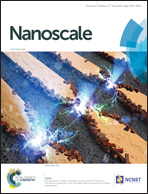A rational microstructure design of SnS2–carbon composites for superior sodium storage performance†
Abstract
Sodium ion batteries (SIBs) have attracted ever-growing attention as promising candidates for large-scale energy storage applications, due to the abundant sodium resources and their low cost. Nevertheless, it is still a significant challenge to realize superior electrode materials with high capacity and good cyclability. To address these problems, herein, a rational microstructure of the SnS2–carbon composite has been designed for superior performance, which consists of MWNTs as a carbon matrix, the SnS2 nanosheet (NS) as an active material, the outer carbon coating as a protection layer, as well as the interior void space for volume accommodation. As an anode material for SIBs, the so-produced MWNT@SnS2 NS@C electrode delivered a high initial capacity of 910 mA h g−1 at 100 mA g−1 and a good retention of 78% after 100 cycles. The sodium storage mechanism of SnS2 was systematically studied through CV, ex situ XPS, and ex situ HRTEM characterization studies, disclosing the reversible conversion and alloying reactions of SnS2 during sodiation/desodiation processes. Moreover, ex situ TEM was further applied to clarify the relationships between the SnS2–C microstructure and sodium storage performance. Our result represents a significant step towards rational design electrodes with high capacity and cyclability for sodium ion batteries.



 Please wait while we load your content...
Please wait while we load your content...